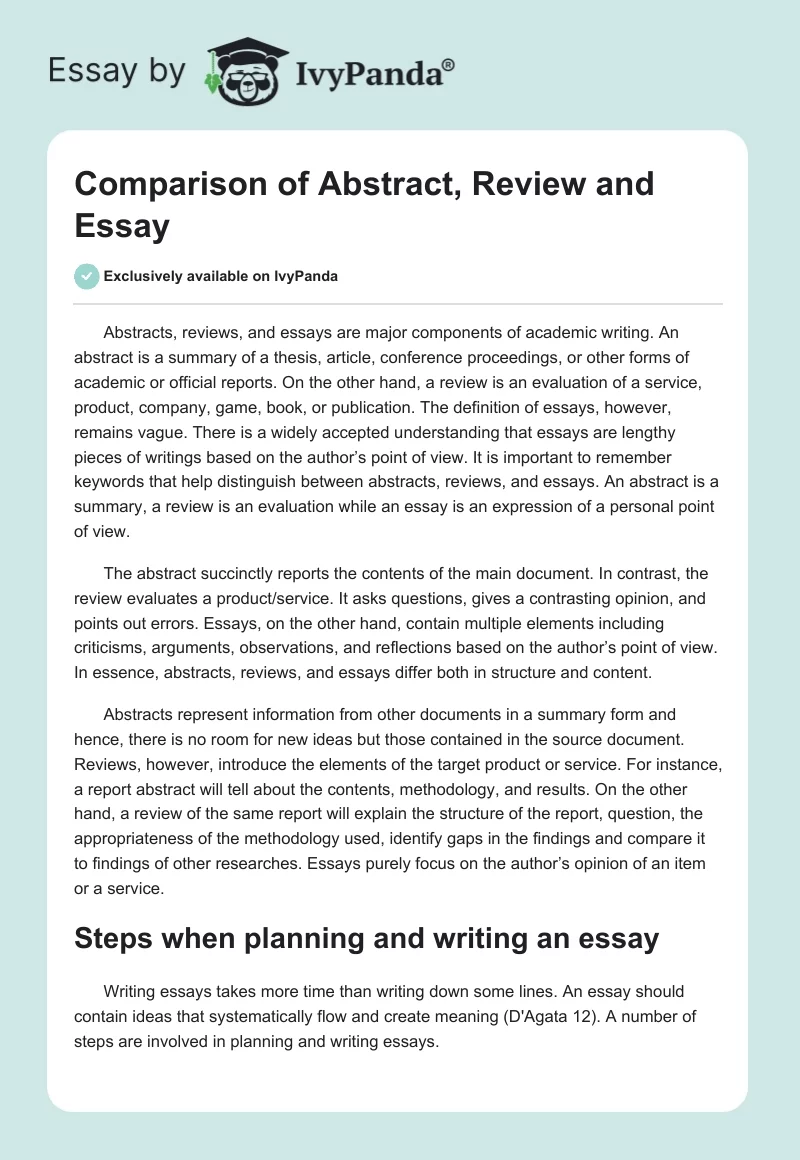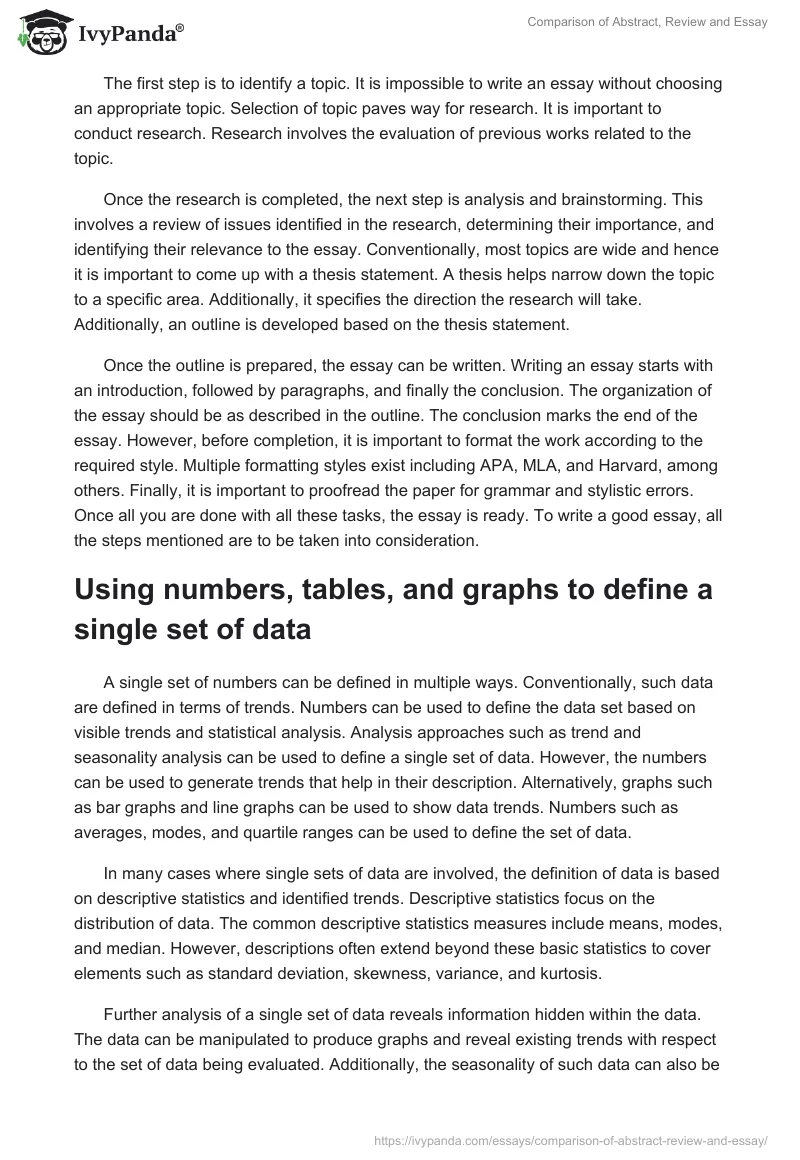Abstracts, reviews, and essays are major components of academic writing. An abstract is a summary of a thesis, article, conference proceedings, or other forms of academic or official reports. On the other hand, a review is an evaluation of a service, product, company, game, book, or publication. The definition of essays, however, remains vague. There is a widely accepted understanding that essays are lengthy pieces of writings based on the author’s point of view. It is important to remember keywords that help distinguish between abstracts, reviews, and essays. An abstract is a summary, a review is an evaluation while an essay is an expression of a personal point of view.
The abstract succinctly reports the contents of the main document. In contrast, the review evaluates a product/service. It asks questions, gives a contrasting opinion, and points out errors. Essays, on the other hand, contain multiple elements including criticisms, arguments, observations, and reflections based on the author’s point of view. In essence, abstracts, reviews, and essays differ both in structure and content.
Abstracts represent information from other documents in a summary form and hence, there is no room for new ideas but those contained in the source document. Reviews, however, introduce the elements of the target product or service. For instance, a report abstract will tell about the contents, methodology, and results. On the other hand, a review of the same report will explain the structure of the report, question, the appropriateness of the methodology used, identify gaps in the findings and compare it to findings of other researches. Essays purely focus on the author’s opinion of an item or a service.
Steps when planning and writing an essay
Writing essays takes more time than writing down some lines. An essay should contain ideas that systematically flow and create meaning (D’Agata 12). A number of steps are involved in planning and writing essays.
The first step is to identify a topic. It is impossible to write an essay without choosing an appropriate topic. Selection of topic paves way for research. It is important to conduct research. Research involves the evaluation of previous works related to the topic.
Once the research is completed, the next step is analysis and brainstorming. This involves a review of issues identified in the research, determining their importance, and identifying their relevance to the essay. Conventionally, most topics are wide and hence it is important to come up with a thesis statement. A thesis helps narrow down the topic to a specific area. Additionally, it specifies the direction the research will take. Additionally, an outline is developed based on the thesis statement.
Once the outline is prepared, the essay can be written. Writing an essay starts with an introduction, followed by paragraphs, and finally the conclusion. The organization of the essay should be as described in the outline. The conclusion marks the end of the essay. However, before completion, it is important to format the work according to the required style. Multiple formatting styles exist including APA, MLA, and Harvard, among others. Finally, it is important to proofread the paper for grammar and stylistic errors. Once all you are done with all these tasks, the essay is ready. To write a good essay, all the steps mentioned are to be taken into consideration.
Using numbers, tables, and graphs to define a single set of data
A single set of numbers can be defined in multiple ways. Conventionally, such data are defined in terms of trends. Numbers can be used to define the data set based on visible trends and statistical analysis. Analysis approaches such as trend and seasonality analysis can be used to define a single set of data. However, the numbers can be used to generate trends that help in their description. Alternatively, graphs such as bar graphs and line graphs can be used to show data trends. Numbers such as averages, modes, and quartile ranges can be used to define the set of data.
In many cases where single sets of data are involved, the definition of data is based on descriptive statistics and identified trends. Descriptive statistics focus on the distribution of data. The common descriptive statistics measures include means, modes, and median. However, descriptions often extend beyond these basic statistics to cover elements such as standard deviation, skewness, variance, and kurtosis.
Further analysis of a single set of data reveals information hidden within the data. The data can be manipulated to produce graphs and reveal existing trends with respect to the set of data being evaluated. Additionally, the seasonality of such data can also be revealed through further analysis. However, what can be done in describing a single set of data is limited to the data itself unlike two or more sets of data where the relationship between data is evaluated.
The use of numbers, tables, and graphs to describe an association between two sets of data
Association between two sets of data can be described using numbers, tables, and graphs. Numbers, conventionally, form the basis of analysis. Such analysis can include a comparison of means and other statistical indicators. Additionally, statistical analysis on sets of data can reveal their association. Such analysis includes correlation analysis, T-tests, and regression analysis, among others. Additionally, the data can be used to create relational equations which define the relation between the two sets. On the other hand, tables can offer a visual way of comparing the data sets. For instance, correlation tables can be used to compare data. Correlational analysis often seeks to establish whether one set of data can predict the trends of another set of data.
Graphs also offer a visual platform for the comparison of the data. Bar graphs and line graphs are the best for the comparison of such data. Based on graphical presentations, it is easy to define trends between data. For instance, such graphs make it possible to conclude whether a large value in data set A will result in a small or a large value in dataset B. This way the relationship between the two datasets will be appropriately defined and represented.
Unlike a single set of data, there is a lot that can be derived from two sets of data. It is important to note that in addition to the analysis running in a single set of data, two sets of data introduce the element of relationships. As a matter of fact, where two sets of data are involved, it is important to describe how one set of data relates to the other and vice-versa.
Works Cited
D’Agata, John. The Lost Origins of the Essay. St Paul: Graywolf Press, 2009. Print.


